Airline Disaster: Evaluating the Failure of Professional Code of Conduct
VerifiedAdded on 2023/01/19
|15
|5225
|73
AI Summary
This report evaluates recent airline disasters and the failure of professional code of conduct, focusing on the case studies of Ethiopian Airlines Boeing 737 Max 8 and Lion Air Flight 610. It examines the ethical perspective, recommendations, and the importance of compliance with business ethics in the aviation industry.
Contribute Materials
Your contribution can guide someone’s learning journey. Share your
documents today.
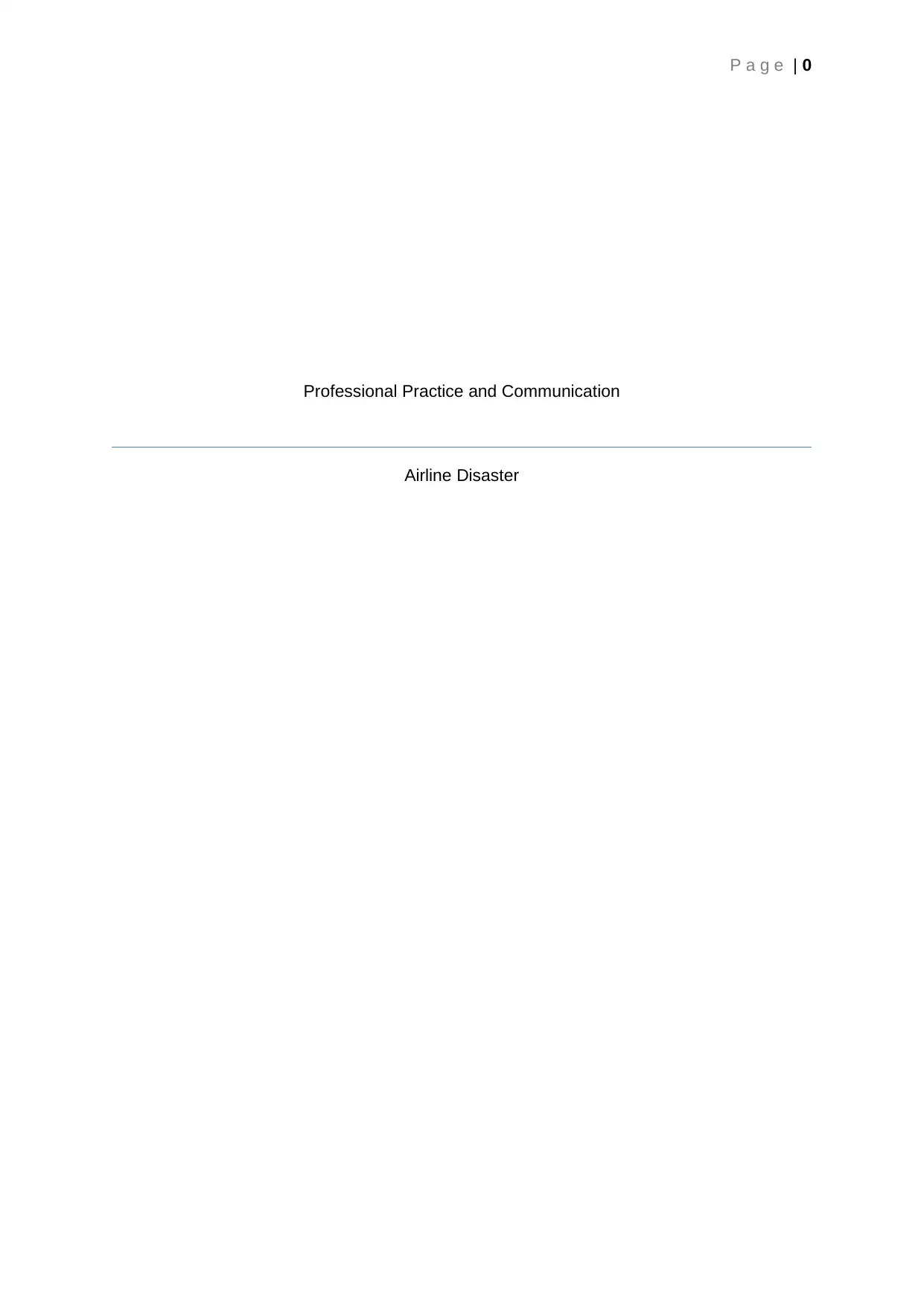
P a g e | 0
Professional Practice and Communication
Airline Disaster
Professional Practice and Communication
Airline Disaster
Secure Best Marks with AI Grader
Need help grading? Try our AI Grader for instant feedback on your assignments.
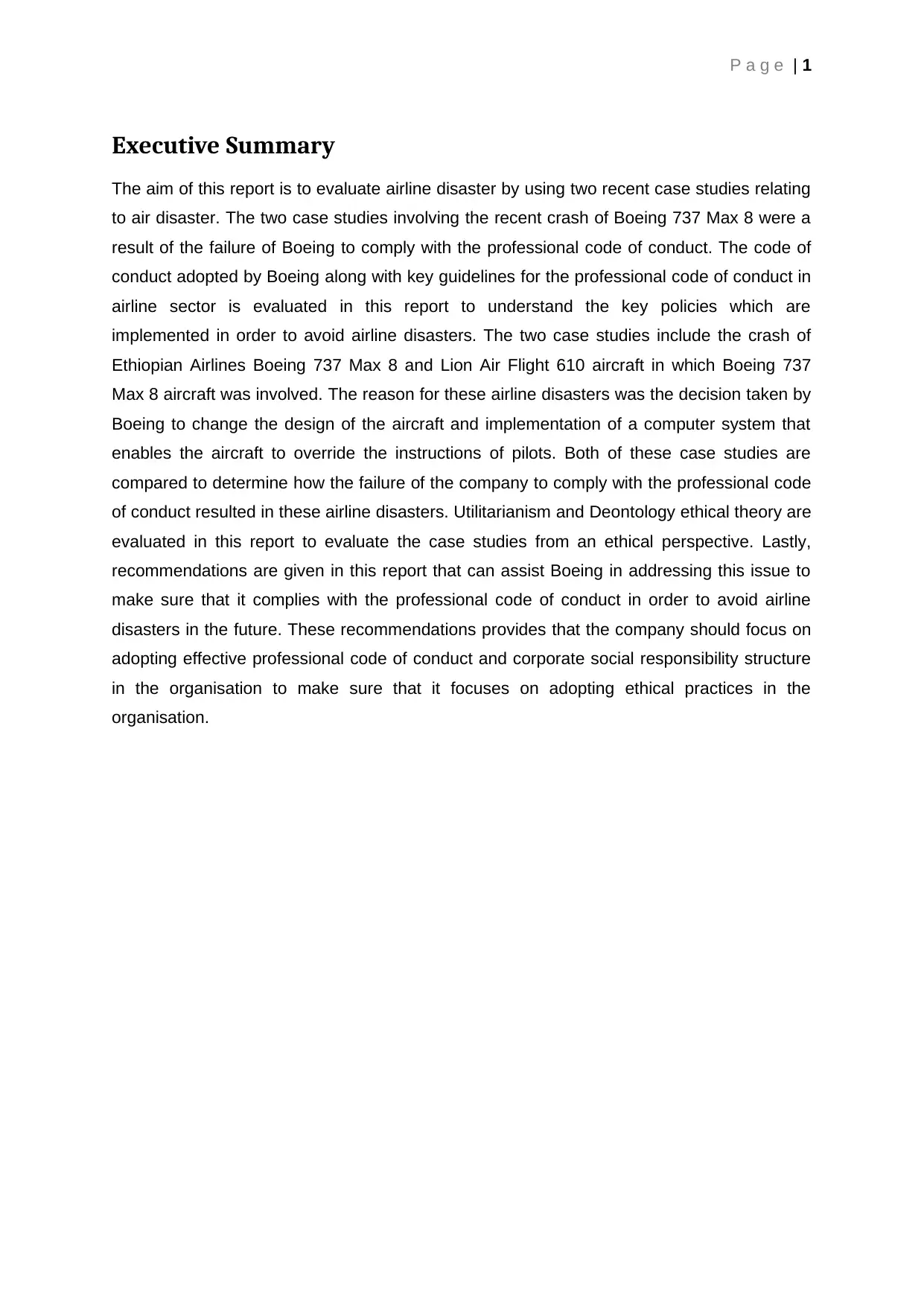
P a g e | 1
Executive Summary
The aim of this report is to evaluate airline disaster by using two recent case studies relating
to air disaster. The two case studies involving the recent crash of Boeing 737 Max 8 were a
result of the failure of Boeing to comply with the professional code of conduct. The code of
conduct adopted by Boeing along with key guidelines for the professional code of conduct in
airline sector is evaluated in this report to understand the key policies which are
implemented in order to avoid airline disasters. The two case studies include the crash of
Ethiopian Airlines Boeing 737 Max 8 and Lion Air Flight 610 aircraft in which Boeing 737
Max 8 aircraft was involved. The reason for these airline disasters was the decision taken by
Boeing to change the design of the aircraft and implementation of a computer system that
enables the aircraft to override the instructions of pilots. Both of these case studies are
compared to determine how the failure of the company to comply with the professional code
of conduct resulted in these airline disasters. Utilitarianism and Deontology ethical theory are
evaluated in this report to evaluate the case studies from an ethical perspective. Lastly,
recommendations are given in this report that can assist Boeing in addressing this issue to
make sure that it complies with the professional code of conduct in order to avoid airline
disasters in the future. These recommendations provides that the company should focus on
adopting effective professional code of conduct and corporate social responsibility structure
in the organisation to make sure that it focuses on adopting ethical practices in the
organisation.
Executive Summary
The aim of this report is to evaluate airline disaster by using two recent case studies relating
to air disaster. The two case studies involving the recent crash of Boeing 737 Max 8 were a
result of the failure of Boeing to comply with the professional code of conduct. The code of
conduct adopted by Boeing along with key guidelines for the professional code of conduct in
airline sector is evaluated in this report to understand the key policies which are
implemented in order to avoid airline disasters. The two case studies include the crash of
Ethiopian Airlines Boeing 737 Max 8 and Lion Air Flight 610 aircraft in which Boeing 737
Max 8 aircraft was involved. The reason for these airline disasters was the decision taken by
Boeing to change the design of the aircraft and implementation of a computer system that
enables the aircraft to override the instructions of pilots. Both of these case studies are
compared to determine how the failure of the company to comply with the professional code
of conduct resulted in these airline disasters. Utilitarianism and Deontology ethical theory are
evaluated in this report to evaluate the case studies from an ethical perspective. Lastly,
recommendations are given in this report that can assist Boeing in addressing this issue to
make sure that it complies with the professional code of conduct in order to avoid airline
disasters in the future. These recommendations provides that the company should focus on
adopting effective professional code of conduct and corporate social responsibility structure
in the organisation to make sure that it focuses on adopting ethical practices in the
organisation.
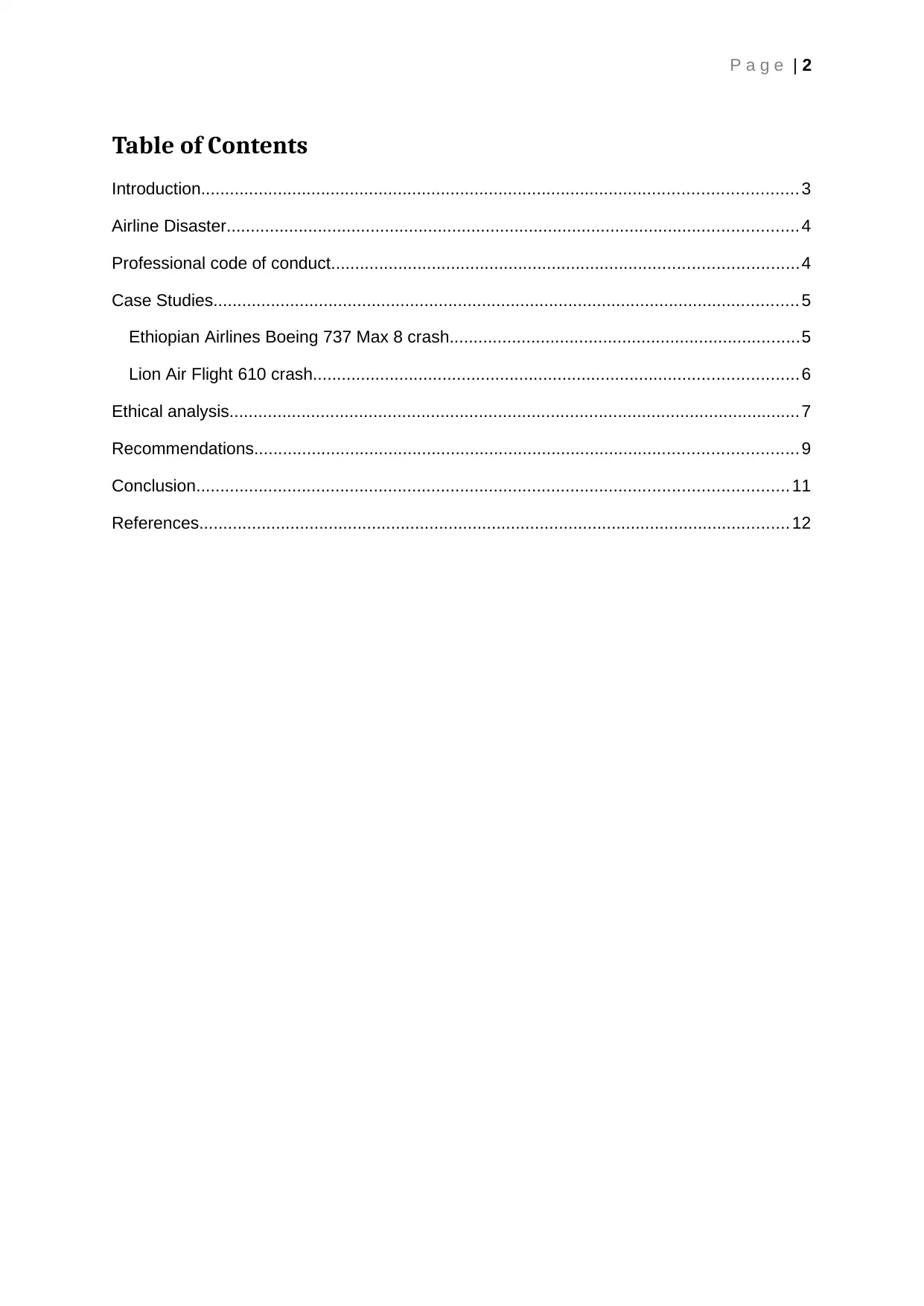
P a g e | 2
Table of Contents
Introduction............................................................................................................................ 3
Airline Disaster....................................................................................................................... 4
Professional code of conduct.................................................................................................4
Case Studies.......................................................................................................................... 5
Ethiopian Airlines Boeing 737 Max 8 crash.........................................................................5
Lion Air Flight 610 crash.....................................................................................................6
Ethical analysis....................................................................................................................... 7
Recommendations................................................................................................................. 9
Conclusion........................................................................................................................... 11
References........................................................................................................................... 12
Table of Contents
Introduction............................................................................................................................ 3
Airline Disaster....................................................................................................................... 4
Professional code of conduct.................................................................................................4
Case Studies.......................................................................................................................... 5
Ethiopian Airlines Boeing 737 Max 8 crash.........................................................................5
Lion Air Flight 610 crash.....................................................................................................6
Ethical analysis....................................................................................................................... 7
Recommendations................................................................................................................. 9
Conclusion........................................................................................................................... 11
References........................................................................................................................... 12
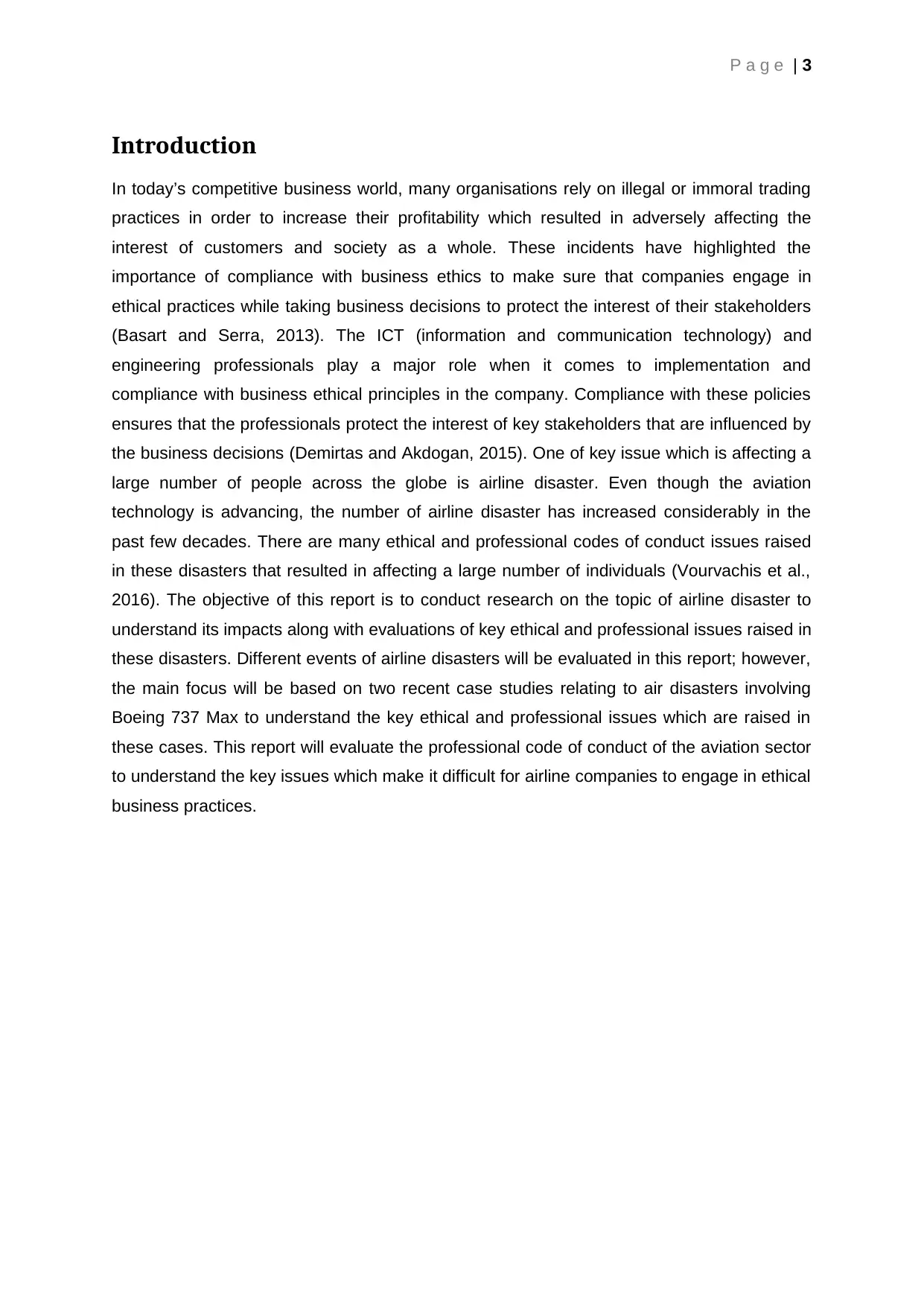
P a g e | 3
Introduction
In today’s competitive business world, many organisations rely on illegal or immoral trading
practices in order to increase their profitability which resulted in adversely affecting the
interest of customers and society as a whole. These incidents have highlighted the
importance of compliance with business ethics to make sure that companies engage in
ethical practices while taking business decisions to protect the interest of their stakeholders
(Basart and Serra, 2013). The ICT (information and communication technology) and
engineering professionals play a major role when it comes to implementation and
compliance with business ethical principles in the company. Compliance with these policies
ensures that the professionals protect the interest of key stakeholders that are influenced by
the business decisions (Demirtas and Akdogan, 2015). One of key issue which is affecting a
large number of people across the globe is airline disaster. Even though the aviation
technology is advancing, the number of airline disaster has increased considerably in the
past few decades. There are many ethical and professional codes of conduct issues raised
in these disasters that resulted in affecting a large number of individuals (Vourvachis et al.,
2016). The objective of this report is to conduct research on the topic of airline disaster to
understand its impacts along with evaluations of key ethical and professional issues raised in
these disasters. Different events of airline disasters will be evaluated in this report; however,
the main focus will be based on two recent case studies relating to air disasters involving
Boeing 737 Max to understand the key ethical and professional issues which are raised in
these cases. This report will evaluate the professional code of conduct of the aviation sector
to understand the key issues which make it difficult for airline companies to engage in ethical
business practices.
Introduction
In today’s competitive business world, many organisations rely on illegal or immoral trading
practices in order to increase their profitability which resulted in adversely affecting the
interest of customers and society as a whole. These incidents have highlighted the
importance of compliance with business ethics to make sure that companies engage in
ethical practices while taking business decisions to protect the interest of their stakeholders
(Basart and Serra, 2013). The ICT (information and communication technology) and
engineering professionals play a major role when it comes to implementation and
compliance with business ethical principles in the company. Compliance with these policies
ensures that the professionals protect the interest of key stakeholders that are influenced by
the business decisions (Demirtas and Akdogan, 2015). One of key issue which is affecting a
large number of people across the globe is airline disaster. Even though the aviation
technology is advancing, the number of airline disaster has increased considerably in the
past few decades. There are many ethical and professional codes of conduct issues raised
in these disasters that resulted in affecting a large number of individuals (Vourvachis et al.,
2016). The objective of this report is to conduct research on the topic of airline disaster to
understand its impacts along with evaluations of key ethical and professional issues raised in
these disasters. Different events of airline disasters will be evaluated in this report; however,
the main focus will be based on two recent case studies relating to air disasters involving
Boeing 737 Max to understand the key ethical and professional issues which are raised in
these cases. This report will evaluate the professional code of conduct of the aviation sector
to understand the key issues which make it difficult for airline companies to engage in ethical
business practices.
Secure Best Marks with AI Grader
Need help grading? Try our AI Grader for instant feedback on your assignments.
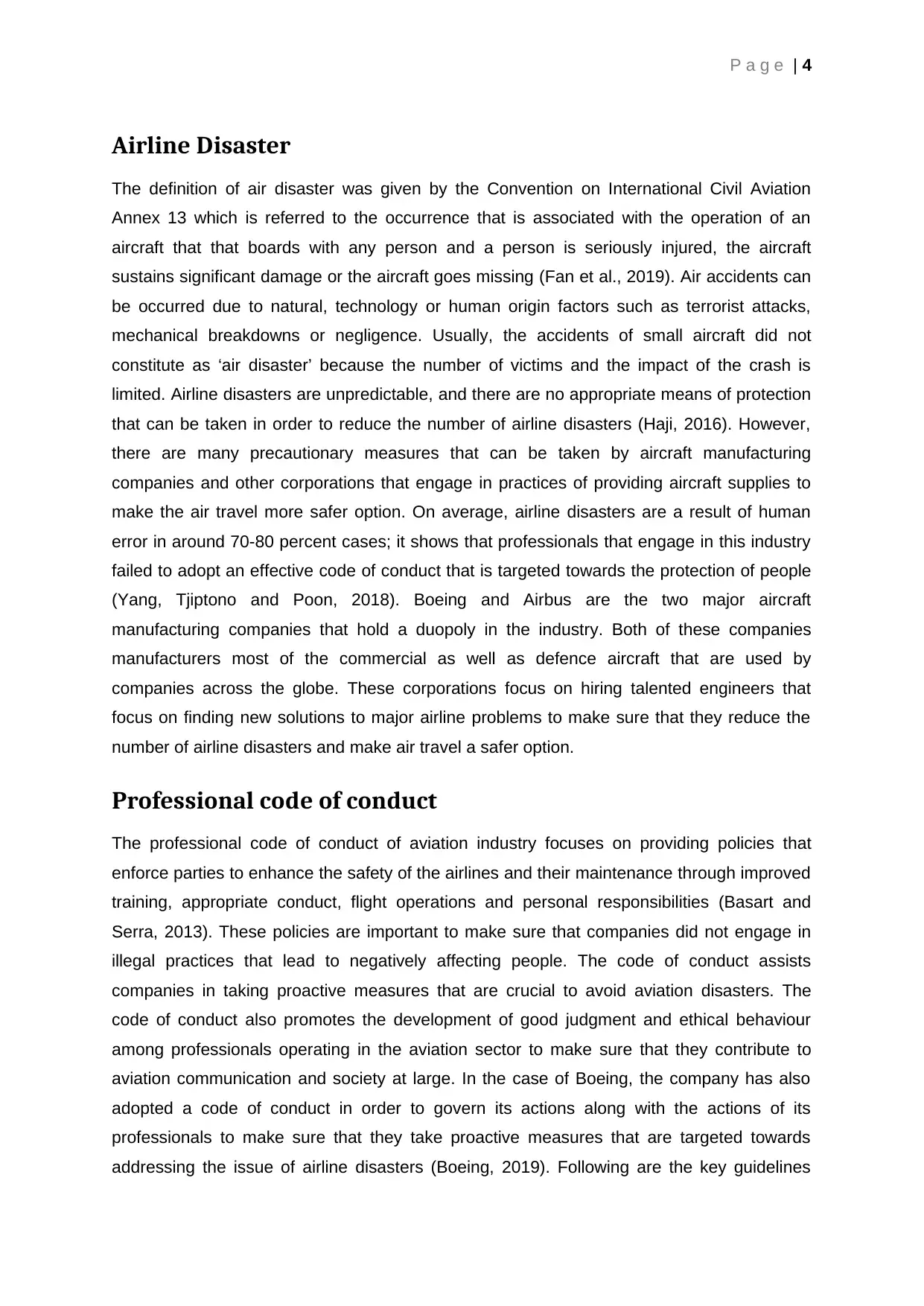
P a g e | 4
Airline Disaster
The definition of air disaster was given by the Convention on International Civil Aviation
Annex 13 which is referred to the occurrence that is associated with the operation of an
aircraft that that boards with any person and a person is seriously injured, the aircraft
sustains significant damage or the aircraft goes missing (Fan et al., 2019). Air accidents can
be occurred due to natural, technology or human origin factors such as terrorist attacks,
mechanical breakdowns or negligence. Usually, the accidents of small aircraft did not
constitute as ‘air disaster’ because the number of victims and the impact of the crash is
limited. Airline disasters are unpredictable, and there are no appropriate means of protection
that can be taken in order to reduce the number of airline disasters (Haji, 2016). However,
there are many precautionary measures that can be taken by aircraft manufacturing
companies and other corporations that engage in practices of providing aircraft supplies to
make the air travel more safer option. On average, airline disasters are a result of human
error in around 70-80 percent cases; it shows that professionals that engage in this industry
failed to adopt an effective code of conduct that is targeted towards the protection of people
(Yang, Tjiptono and Poon, 2018). Boeing and Airbus are the two major aircraft
manufacturing companies that hold a duopoly in the industry. Both of these companies
manufacturers most of the commercial as well as defence aircraft that are used by
companies across the globe. These corporations focus on hiring talented engineers that
focus on finding new solutions to major airline problems to make sure that they reduce the
number of airline disasters and make air travel a safer option.
Professional code of conduct
The professional code of conduct of aviation industry focuses on providing policies that
enforce parties to enhance the safety of the airlines and their maintenance through improved
training, appropriate conduct, flight operations and personal responsibilities (Basart and
Serra, 2013). These policies are important to make sure that companies did not engage in
illegal practices that lead to negatively affecting people. The code of conduct assists
companies in taking proactive measures that are crucial to avoid aviation disasters. The
code of conduct also promotes the development of good judgment and ethical behaviour
among professionals operating in the aviation sector to make sure that they contribute to
aviation communication and society at large. In the case of Boeing, the company has also
adopted a code of conduct in order to govern its actions along with the actions of its
professionals to make sure that they take proactive measures that are targeted towards
addressing the issue of airline disasters (Boeing, 2019). Following are the key guidelines
Airline Disaster
The definition of air disaster was given by the Convention on International Civil Aviation
Annex 13 which is referred to the occurrence that is associated with the operation of an
aircraft that that boards with any person and a person is seriously injured, the aircraft
sustains significant damage or the aircraft goes missing (Fan et al., 2019). Air accidents can
be occurred due to natural, technology or human origin factors such as terrorist attacks,
mechanical breakdowns or negligence. Usually, the accidents of small aircraft did not
constitute as ‘air disaster’ because the number of victims and the impact of the crash is
limited. Airline disasters are unpredictable, and there are no appropriate means of protection
that can be taken in order to reduce the number of airline disasters (Haji, 2016). However,
there are many precautionary measures that can be taken by aircraft manufacturing
companies and other corporations that engage in practices of providing aircraft supplies to
make the air travel more safer option. On average, airline disasters are a result of human
error in around 70-80 percent cases; it shows that professionals that engage in this industry
failed to adopt an effective code of conduct that is targeted towards the protection of people
(Yang, Tjiptono and Poon, 2018). Boeing and Airbus are the two major aircraft
manufacturing companies that hold a duopoly in the industry. Both of these companies
manufacturers most of the commercial as well as defence aircraft that are used by
companies across the globe. These corporations focus on hiring talented engineers that
focus on finding new solutions to major airline problems to make sure that they reduce the
number of airline disasters and make air travel a safer option.
Professional code of conduct
The professional code of conduct of aviation industry focuses on providing policies that
enforce parties to enhance the safety of the airlines and their maintenance through improved
training, appropriate conduct, flight operations and personal responsibilities (Basart and
Serra, 2013). These policies are important to make sure that companies did not engage in
illegal practices that lead to negatively affecting people. The code of conduct assists
companies in taking proactive measures that are crucial to avoid aviation disasters. The
code of conduct also promotes the development of good judgment and ethical behaviour
among professionals operating in the aviation sector to make sure that they contribute to
aviation communication and society at large. In the case of Boeing, the company has also
adopted a code of conduct in order to govern its actions along with the actions of its
professionals to make sure that they take proactive measures that are targeted towards
addressing the issue of airline disasters (Boeing, 2019). Following are the key guidelines

P a g e | 5
which professionals, engineers and employees at Boeing have to follow while discharging
their duties:
They must protect the interest and assets of customers, suppliers and the company
while discharging their duties (SEC, 2019).
They must not engage in practices which resulted in conflict their personal interest
with the interest of the company.
They should not take unfair advantage of their power and position in the company to
conduct inappropriate actions or misuse the non-public information of the company to
engage in insider trading.
They should, without exception, comply with applicable laws, rules and regulations
that govern their actions.
They should not promote illegal or unethical conduct to management or other
authorities in the organisation.
They must follow all restrictions on use and disclosure of information to protect the
sensitive information from protection and disclose such information only to legal
authorities that are permitted by the law to collect such information (SEC, 2019).
Although this code of conduct is focused on reducing the number of airline disasters by
Boeing; however, there are many incidents in which air disasters occurred in which the
aircraft manufactured by Boeing was involved. For example, in 2016, a FlyDubai Boeing
737-800 was involved in an accident, and the aircraft crashed which resulted in the death of
62 people on board. On 17th November 2013, Tatarstan Airline Boeing 737 was crashed
while landing in Kazan, Russia in which all 50 people on board were killed (Ragozin, 2013).
Although in most of these cases, the crashes were a result of the failure of the machines or
human errors which are difficult to be addressed by Boeing; however, there are two recent
cases in which the failure of the professional code of conduct by Boeing was a result of the
crasher.
Case Studies
Ethiopian Airlines Boeing 737 Max 8 crash
The first case study is regarding the crash of an Ethiopian Airline jet that take-off from Addis
Ababa and crashed six minutes after its take-off resulted in killing everyone on board. In this
airline, there were 149 passengers on board along with eight crew members (BBC, 2019).
This incident rocked the aviation sector and sparked numerous investigations that found that
these incidents were a result of the failure of the engineers and employees of Boeing. The
which professionals, engineers and employees at Boeing have to follow while discharging
their duties:
They must protect the interest and assets of customers, suppliers and the company
while discharging their duties (SEC, 2019).
They must not engage in practices which resulted in conflict their personal interest
with the interest of the company.
They should not take unfair advantage of their power and position in the company to
conduct inappropriate actions or misuse the non-public information of the company to
engage in insider trading.
They should, without exception, comply with applicable laws, rules and regulations
that govern their actions.
They should not promote illegal or unethical conduct to management or other
authorities in the organisation.
They must follow all restrictions on use and disclosure of information to protect the
sensitive information from protection and disclose such information only to legal
authorities that are permitted by the law to collect such information (SEC, 2019).
Although this code of conduct is focused on reducing the number of airline disasters by
Boeing; however, there are many incidents in which air disasters occurred in which the
aircraft manufactured by Boeing was involved. For example, in 2016, a FlyDubai Boeing
737-800 was involved in an accident, and the aircraft crashed which resulted in the death of
62 people on board. On 17th November 2013, Tatarstan Airline Boeing 737 was crashed
while landing in Kazan, Russia in which all 50 people on board were killed (Ragozin, 2013).
Although in most of these cases, the crashes were a result of the failure of the machines or
human errors which are difficult to be addressed by Boeing; however, there are two recent
cases in which the failure of the professional code of conduct by Boeing was a result of the
crasher.
Case Studies
Ethiopian Airlines Boeing 737 Max 8 crash
The first case study is regarding the crash of an Ethiopian Airline jet that take-off from Addis
Ababa and crashed six minutes after its take-off resulted in killing everyone on board. In this
airline, there were 149 passengers on board along with eight crew members (BBC, 2019).
This incident rocked the aviation sector and sparked numerous investigations that found that
these incidents were a result of the failure of the engineers and employees of Boeing. The

P a g e | 6
airline was a part of the latest airline range offered by Boeing called 787 Max 8s, and it is
known for its fuel efficiency and technological design that was deemed as a safer option than
compared to other options. It was reported in the investigation that the captain and first
officer followed safety procedures which were recommended by Boring for pilots; however,
they could not able to stop the aircraft from going into a fatal dive (Rapier, 2019). This was a
result of the sensors which were added by the engineers of Boeing in the aircraft. The
professionals decided to change the shape of 787 Max 8s in order to make it more likely to
pitch upward on the take-off than compared to other 737s which resulted in changing the
centre of gravity of the aircraft. This assisted in reducing the lift which other aircrafts needed
in order to stay airborne. In order to achieve this objective, the engineers at Boeing came up
with a piece of software that was designed to counteract that tendency to prevent a fatal dive
from happening (BBC, 2019). The computer software was able to detect that the plane is
pitching too far upward by using different sensors after which it pushes the nose of the
aircraft back down automatically.
This design resulted in increasing the fuel efficiency of the aircraft which made it one of the
best-selling aircraft made by Boeing. However, the issue was that the actions taken by the
company to increase the safety of the aircraft resulted in becoming the reason for its crash.
These changes make it riskier for the flight crew to control the flights since their actions were
bypassed by the computer that was giving the signal to the airline to stop the fatal dive (Ellis,
2019). This shows a failure from the part of engineers of Boeing who failed to implement
measures in the aircraft that allowed the pilots to bypass the computer to manually control
the flight. After this incident, more than 300 787 Max 8s were grounded by airline companies
across the globe through voluntary actions or from the order of the government. In this
regards, Boeing stated that the airline is still secured; however, it would be in the best
interest if these airlines are grounded (Paterson, 2019). The software in the flight instructed
the plane to pitch downward without the permission of the pilot and it automatically overrode
attempts by the pilots to pull the place upward. In the investigation, it was found that the
sensors installed in the flight started to send erroneous information to the flight management
system and the same sensor might have triggered the software that leads to the struggle
between the machine and the pilot (BBC, 2019). The decision was made by the computer
with bad information which leads to the crash.
Lion Air Flight 610 crash
Six months prior to the Ethiopian Airlines Boeing 737 Max 8 crash, another major airline
disaster was reported when Lion Air Flight 610 was crashed in the sea (Glanz et al., 2019). It
was a domestic flight that was operated by Indonesian airline Lion Air. The flight took-off
airline was a part of the latest airline range offered by Boeing called 787 Max 8s, and it is
known for its fuel efficiency and technological design that was deemed as a safer option than
compared to other options. It was reported in the investigation that the captain and first
officer followed safety procedures which were recommended by Boring for pilots; however,
they could not able to stop the aircraft from going into a fatal dive (Rapier, 2019). This was a
result of the sensors which were added by the engineers of Boeing in the aircraft. The
professionals decided to change the shape of 787 Max 8s in order to make it more likely to
pitch upward on the take-off than compared to other 737s which resulted in changing the
centre of gravity of the aircraft. This assisted in reducing the lift which other aircrafts needed
in order to stay airborne. In order to achieve this objective, the engineers at Boeing came up
with a piece of software that was designed to counteract that tendency to prevent a fatal dive
from happening (BBC, 2019). The computer software was able to detect that the plane is
pitching too far upward by using different sensors after which it pushes the nose of the
aircraft back down automatically.
This design resulted in increasing the fuel efficiency of the aircraft which made it one of the
best-selling aircraft made by Boeing. However, the issue was that the actions taken by the
company to increase the safety of the aircraft resulted in becoming the reason for its crash.
These changes make it riskier for the flight crew to control the flights since their actions were
bypassed by the computer that was giving the signal to the airline to stop the fatal dive (Ellis,
2019). This shows a failure from the part of engineers of Boeing who failed to implement
measures in the aircraft that allowed the pilots to bypass the computer to manually control
the flight. After this incident, more than 300 787 Max 8s were grounded by airline companies
across the globe through voluntary actions or from the order of the government. In this
regards, Boeing stated that the airline is still secured; however, it would be in the best
interest if these airlines are grounded (Paterson, 2019). The software in the flight instructed
the plane to pitch downward without the permission of the pilot and it automatically overrode
attempts by the pilots to pull the place upward. In the investigation, it was found that the
sensors installed in the flight started to send erroneous information to the flight management
system and the same sensor might have triggered the software that leads to the struggle
between the machine and the pilot (BBC, 2019). The decision was made by the computer
with bad information which leads to the crash.
Lion Air Flight 610 crash
Six months prior to the Ethiopian Airlines Boeing 737 Max 8 crash, another major airline
disaster was reported when Lion Air Flight 610 was crashed in the sea (Glanz et al., 2019). It
was a domestic flight that was operated by Indonesian airline Lion Air. The flight took-off
Paraphrase This Document
Need a fresh take? Get an instant paraphrase of this document with our AI Paraphraser
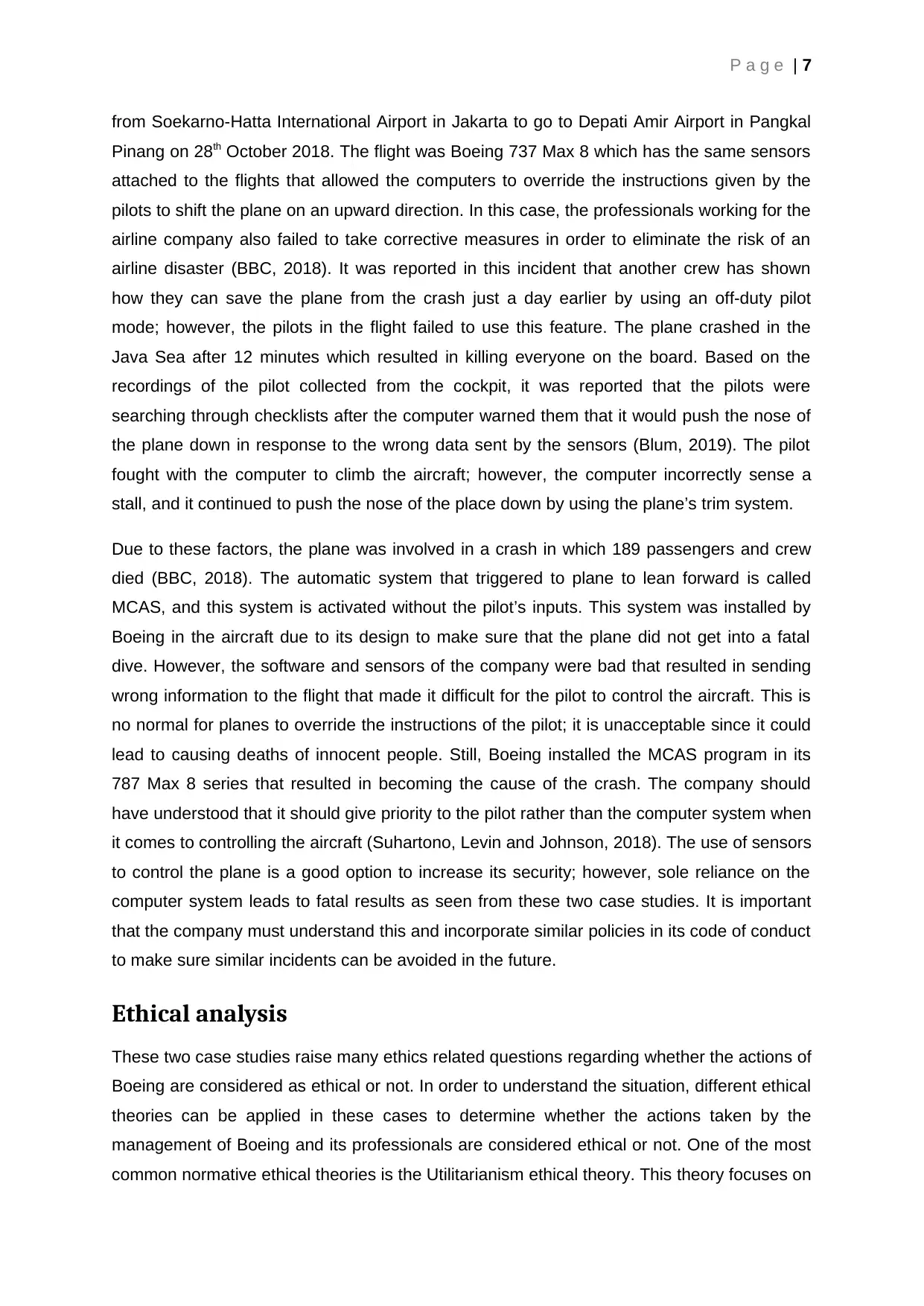
P a g e | 7
from Soekarno-Hatta International Airport in Jakarta to go to Depati Amir Airport in Pangkal
Pinang on 28th October 2018. The flight was Boeing 737 Max 8 which has the same sensors
attached to the flights that allowed the computers to override the instructions given by the
pilots to shift the plane on an upward direction. In this case, the professionals working for the
airline company also failed to take corrective measures in order to eliminate the risk of an
airline disaster (BBC, 2018). It was reported in this incident that another crew has shown
how they can save the plane from the crash just a day earlier by using an off-duty pilot
mode; however, the pilots in the flight failed to use this feature. The plane crashed in the
Java Sea after 12 minutes which resulted in killing everyone on the board. Based on the
recordings of the pilot collected from the cockpit, it was reported that the pilots were
searching through checklists after the computer warned them that it would push the nose of
the plane down in response to the wrong data sent by the sensors (Blum, 2019). The pilot
fought with the computer to climb the aircraft; however, the computer incorrectly sense a
stall, and it continued to push the nose of the place down by using the plane’s trim system.
Due to these factors, the plane was involved in a crash in which 189 passengers and crew
died (BBC, 2018). The automatic system that triggered to plane to lean forward is called
MCAS, and this system is activated without the pilot’s inputs. This system was installed by
Boeing in the aircraft due to its design to make sure that the plane did not get into a fatal
dive. However, the software and sensors of the company were bad that resulted in sending
wrong information to the flight that made it difficult for the pilot to control the aircraft. This is
no normal for planes to override the instructions of the pilot; it is unacceptable since it could
lead to causing deaths of innocent people. Still, Boeing installed the MCAS program in its
787 Max 8 series that resulted in becoming the cause of the crash. The company should
have understood that it should give priority to the pilot rather than the computer system when
it comes to controlling the aircraft (Suhartono, Levin and Johnson, 2018). The use of sensors
to control the plane is a good option to increase its security; however, sole reliance on the
computer system leads to fatal results as seen from these two case studies. It is important
that the company must understand this and incorporate similar policies in its code of conduct
to make sure similar incidents can be avoided in the future.
Ethical analysis
These two case studies raise many ethics related questions regarding whether the actions of
Boeing are considered as ethical or not. In order to understand the situation, different ethical
theories can be applied in these cases to determine whether the actions taken by the
management of Boeing and its professionals are considered ethical or not. One of the most
common normative ethical theories is the Utilitarianism ethical theory. This theory focuses on
from Soekarno-Hatta International Airport in Jakarta to go to Depati Amir Airport in Pangkal
Pinang on 28th October 2018. The flight was Boeing 737 Max 8 which has the same sensors
attached to the flights that allowed the computers to override the instructions given by the
pilots to shift the plane on an upward direction. In this case, the professionals working for the
airline company also failed to take corrective measures in order to eliminate the risk of an
airline disaster (BBC, 2018). It was reported in this incident that another crew has shown
how they can save the plane from the crash just a day earlier by using an off-duty pilot
mode; however, the pilots in the flight failed to use this feature. The plane crashed in the
Java Sea after 12 minutes which resulted in killing everyone on the board. Based on the
recordings of the pilot collected from the cockpit, it was reported that the pilots were
searching through checklists after the computer warned them that it would push the nose of
the plane down in response to the wrong data sent by the sensors (Blum, 2019). The pilot
fought with the computer to climb the aircraft; however, the computer incorrectly sense a
stall, and it continued to push the nose of the place down by using the plane’s trim system.
Due to these factors, the plane was involved in a crash in which 189 passengers and crew
died (BBC, 2018). The automatic system that triggered to plane to lean forward is called
MCAS, and this system is activated without the pilot’s inputs. This system was installed by
Boeing in the aircraft due to its design to make sure that the plane did not get into a fatal
dive. However, the software and sensors of the company were bad that resulted in sending
wrong information to the flight that made it difficult for the pilot to control the aircraft. This is
no normal for planes to override the instructions of the pilot; it is unacceptable since it could
lead to causing deaths of innocent people. Still, Boeing installed the MCAS program in its
787 Max 8 series that resulted in becoming the cause of the crash. The company should
have understood that it should give priority to the pilot rather than the computer system when
it comes to controlling the aircraft (Suhartono, Levin and Johnson, 2018). The use of sensors
to control the plane is a good option to increase its security; however, sole reliance on the
computer system leads to fatal results as seen from these two case studies. It is important
that the company must understand this and incorporate similar policies in its code of conduct
to make sure similar incidents can be avoided in the future.
Ethical analysis
These two case studies raise many ethics related questions regarding whether the actions of
Boeing are considered as ethical or not. In order to understand the situation, different ethical
theories can be applied in these cases to determine whether the actions taken by the
management of Boeing and its professionals are considered ethical or not. One of the most
common normative ethical theories is the Utilitarianism ethical theory. This theory focuses on

P a g e | 8
the consequences of a situation while judging the morality of a situation (Shafer-Landau,
2012). As per this theory, parties should strive to achieve greater happiness for a greater
number of people through their actions. This theory argues that as long as the
consequences of an action are positive and in the interest of a significant number of people,
it is considered ethical. Based on this theory, the decision taken by the management and
professionals at Boeing is not considered ethical. The engineers at Boeing decided to
change the shape of the airline that resulted in shifted its centre of gravity, and they decided
to rely on sensors to make sure that the plane is able to change its position when it starts to
lean backward. They also failed to give priority to the actions of the pilot since they included
the MCAS system in the plane that overrides the instructions of the pilot above the bad
information sent by the sensors in the plane (BBC, 2019).
The company failed to test the capabilities of these sensors, and they relied on them in order
to sell more aircraft. The 787 Max 8 is the highest selling aircraft by Boeing which shows that
the company prioritised maximisation of profits above the interest of its stakeholders which
include passengers and crew members. The company should have sent a software update
after the Lion Air Flight 610 crash; however, it failed to do so. The company later admitted its
mistake after the crash of Ethiopian Airlines Boeing 737 Max 8 after which it told airline
companies that it would send a software update to stop the plane from overriding the
instructions of the pilot (Chang, Lee and Mas, 2019). However, it is already too late because
a large number of innocent people have lost their lives which caused great grievance to their
families based on which the greater happiness of a greater number of people is not
achieved. Thus, this decision of Boeing is considered as unethical. Another relevant
normative ethical theory in this regards is the Deontology ethical theory. This theory is
opposed to the Utilitarianism ethical theory as it focuses on the morality of the actions rather
than its consequences. As per this theory, a just and fair society cannot be established
unless parties violate their duties (Dion, 2012). This theory argues that legal actions are
those in which parties did not breach their duties even if their consequences adversely affect
the interest of a large number of individuals.
This theory emphasises the ‘maxim’ of parties to determine the actual purpose of their
actions. As per this theory, the actions taken by the management of Boeing and its
professionals are considered unethical because they violated their duties. They did not
comply with the code of conduct of the company that clearly specifies that they must
prioritise the interest of customers, employees and society rather than their personal interest
(Wichter, 2019). The decision taken by them to give more power to the computer rather than
the pilot was unethical since it contradicted with the duty of the company to prioritise the
safety of its customers and people who travel through its aircraft. Based on these ethical
the consequences of a situation while judging the morality of a situation (Shafer-Landau,
2012). As per this theory, parties should strive to achieve greater happiness for a greater
number of people through their actions. This theory argues that as long as the
consequences of an action are positive and in the interest of a significant number of people,
it is considered ethical. Based on this theory, the decision taken by the management and
professionals at Boeing is not considered ethical. The engineers at Boeing decided to
change the shape of the airline that resulted in shifted its centre of gravity, and they decided
to rely on sensors to make sure that the plane is able to change its position when it starts to
lean backward. They also failed to give priority to the actions of the pilot since they included
the MCAS system in the plane that overrides the instructions of the pilot above the bad
information sent by the sensors in the plane (BBC, 2019).
The company failed to test the capabilities of these sensors, and they relied on them in order
to sell more aircraft. The 787 Max 8 is the highest selling aircraft by Boeing which shows that
the company prioritised maximisation of profits above the interest of its stakeholders which
include passengers and crew members. The company should have sent a software update
after the Lion Air Flight 610 crash; however, it failed to do so. The company later admitted its
mistake after the crash of Ethiopian Airlines Boeing 737 Max 8 after which it told airline
companies that it would send a software update to stop the plane from overriding the
instructions of the pilot (Chang, Lee and Mas, 2019). However, it is already too late because
a large number of innocent people have lost their lives which caused great grievance to their
families based on which the greater happiness of a greater number of people is not
achieved. Thus, this decision of Boeing is considered as unethical. Another relevant
normative ethical theory in this regards is the Deontology ethical theory. This theory is
opposed to the Utilitarianism ethical theory as it focuses on the morality of the actions rather
than its consequences. As per this theory, a just and fair society cannot be established
unless parties violate their duties (Dion, 2012). This theory argues that legal actions are
those in which parties did not breach their duties even if their consequences adversely affect
the interest of a large number of individuals.
This theory emphasises the ‘maxim’ of parties to determine the actual purpose of their
actions. As per this theory, the actions taken by the management of Boeing and its
professionals are considered unethical because they violated their duties. They did not
comply with the code of conduct of the company that clearly specifies that they must
prioritise the interest of customers, employees and society rather than their personal interest
(Wichter, 2019). The decision taken by them to give more power to the computer rather than
the pilot was unethical since it contradicted with the duty of the company to prioritise the
safety of its customers and people who travel through its aircraft. Based on these ethical
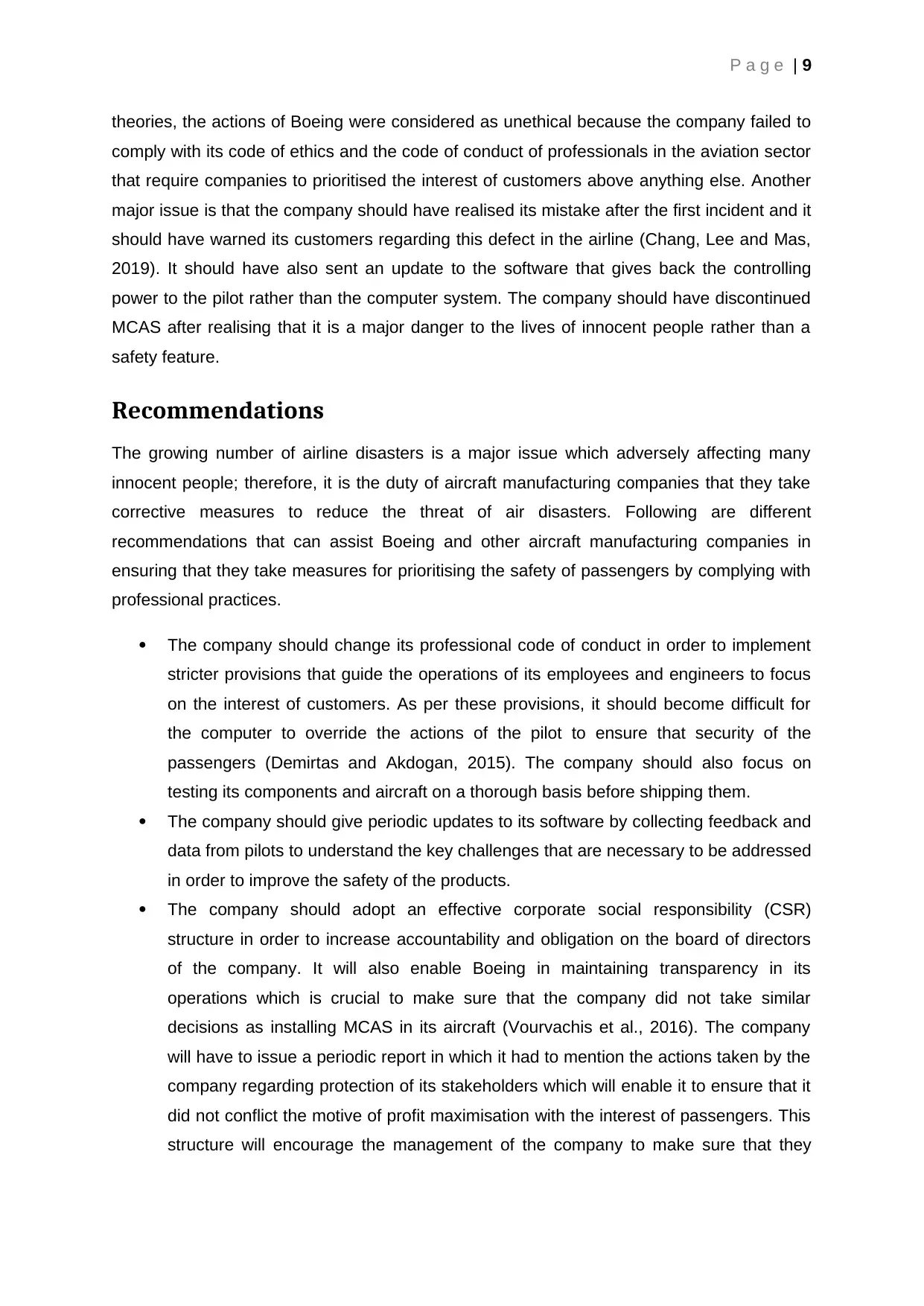
P a g e | 9
theories, the actions of Boeing were considered as unethical because the company failed to
comply with its code of ethics and the code of conduct of professionals in the aviation sector
that require companies to prioritised the interest of customers above anything else. Another
major issue is that the company should have realised its mistake after the first incident and it
should have warned its customers regarding this defect in the airline (Chang, Lee and Mas,
2019). It should have also sent an update to the software that gives back the controlling
power to the pilot rather than the computer system. The company should have discontinued
MCAS after realising that it is a major danger to the lives of innocent people rather than a
safety feature.
Recommendations
The growing number of airline disasters is a major issue which adversely affecting many
innocent people; therefore, it is the duty of aircraft manufacturing companies that they take
corrective measures to reduce the threat of air disasters. Following are different
recommendations that can assist Boeing and other aircraft manufacturing companies in
ensuring that they take measures for prioritising the safety of passengers by complying with
professional practices.
The company should change its professional code of conduct in order to implement
stricter provisions that guide the operations of its employees and engineers to focus
on the interest of customers. As per these provisions, it should become difficult for
the computer to override the actions of the pilot to ensure that security of the
passengers (Demirtas and Akdogan, 2015). The company should also focus on
testing its components and aircraft on a thorough basis before shipping them.
The company should give periodic updates to its software by collecting feedback and
data from pilots to understand the key challenges that are necessary to be addressed
in order to improve the safety of the products.
The company should adopt an effective corporate social responsibility (CSR)
structure in order to increase accountability and obligation on the board of directors
of the company. It will also enable Boeing in maintaining transparency in its
operations which is crucial to make sure that the company did not take similar
decisions as installing MCAS in its aircraft (Vourvachis et al., 2016). The company
will have to issue a periodic report in which it had to mention the actions taken by the
company regarding protection of its stakeholders which will enable it to ensure that it
did not conflict the motive of profit maximisation with the interest of passengers. This
structure will encourage the management of the company to make sure that they
theories, the actions of Boeing were considered as unethical because the company failed to
comply with its code of ethics and the code of conduct of professionals in the aviation sector
that require companies to prioritised the interest of customers above anything else. Another
major issue is that the company should have realised its mistake after the first incident and it
should have warned its customers regarding this defect in the airline (Chang, Lee and Mas,
2019). It should have also sent an update to the software that gives back the controlling
power to the pilot rather than the computer system. The company should have discontinued
MCAS after realising that it is a major danger to the lives of innocent people rather than a
safety feature.
Recommendations
The growing number of airline disasters is a major issue which adversely affecting many
innocent people; therefore, it is the duty of aircraft manufacturing companies that they take
corrective measures to reduce the threat of air disasters. Following are different
recommendations that can assist Boeing and other aircraft manufacturing companies in
ensuring that they take measures for prioritising the safety of passengers by complying with
professional practices.
The company should change its professional code of conduct in order to implement
stricter provisions that guide the operations of its employees and engineers to focus
on the interest of customers. As per these provisions, it should become difficult for
the computer to override the actions of the pilot to ensure that security of the
passengers (Demirtas and Akdogan, 2015). The company should also focus on
testing its components and aircraft on a thorough basis before shipping them.
The company should give periodic updates to its software by collecting feedback and
data from pilots to understand the key challenges that are necessary to be addressed
in order to improve the safety of the products.
The company should adopt an effective corporate social responsibility (CSR)
structure in order to increase accountability and obligation on the board of directors
of the company. It will also enable Boeing in maintaining transparency in its
operations which is crucial to make sure that the company did not take similar
decisions as installing MCAS in its aircraft (Vourvachis et al., 2016). The company
will have to issue a periodic report in which it had to mention the actions taken by the
company regarding protection of its stakeholders which will enable it to ensure that it
did not conflict the motive of profit maximisation with the interest of passengers. This
structure will encourage the management of the company to make sure that they
Secure Best Marks with AI Grader
Need help grading? Try our AI Grader for instant feedback on your assignments.

P a g e | 10
maintain a balance between the interests of stakeholders while taking business
decisions which are crucial to ensure the safety of customers.
The company should embrace its mistakes in order to learn from them in the future.
In the future, the company should be more proactive when it comes to addressing
challenges relating to aircraft malfunctions based on which it should quickly warn its
clients regarding the issues to make sure that they are able to prepare themselves
for these changes (Basart and Serra, 2013). The company should also focus on
creating an open culture in the workplace to make sure that employees are
encouraged to take corrective actions and they are focused towards reducing the
risks in the aircraft to make them safer for use.
The government should provide guidelines for companies operating in the aviation
sector to make sure that they take corrective measures which are focused towards
promoting the safety of passengers in the flight. The number of air disasters is likely
to reduce in the future if the government implements stricter laws for aircraft
manufacturing companies that enforce them to make sure that they did not take the
issue of passengers safety for granted and take proactive measures by complying
with professional code of conduct to ensure that the number of air disasters can be
reduced in the future (Hoppe, 2018).
maintain a balance between the interests of stakeholders while taking business
decisions which are crucial to ensure the safety of customers.
The company should embrace its mistakes in order to learn from them in the future.
In the future, the company should be more proactive when it comes to addressing
challenges relating to aircraft malfunctions based on which it should quickly warn its
clients regarding the issues to make sure that they are able to prepare themselves
for these changes (Basart and Serra, 2013). The company should also focus on
creating an open culture in the workplace to make sure that employees are
encouraged to take corrective actions and they are focused towards reducing the
risks in the aircraft to make them safer for use.
The government should provide guidelines for companies operating in the aviation
sector to make sure that they take corrective measures which are focused towards
promoting the safety of passengers in the flight. The number of air disasters is likely
to reduce in the future if the government implements stricter laws for aircraft
manufacturing companies that enforce them to make sure that they did not take the
issue of passengers safety for granted and take proactive measures by complying
with professional code of conduct to ensure that the number of air disasters can be
reduced in the future (Hoppe, 2018).
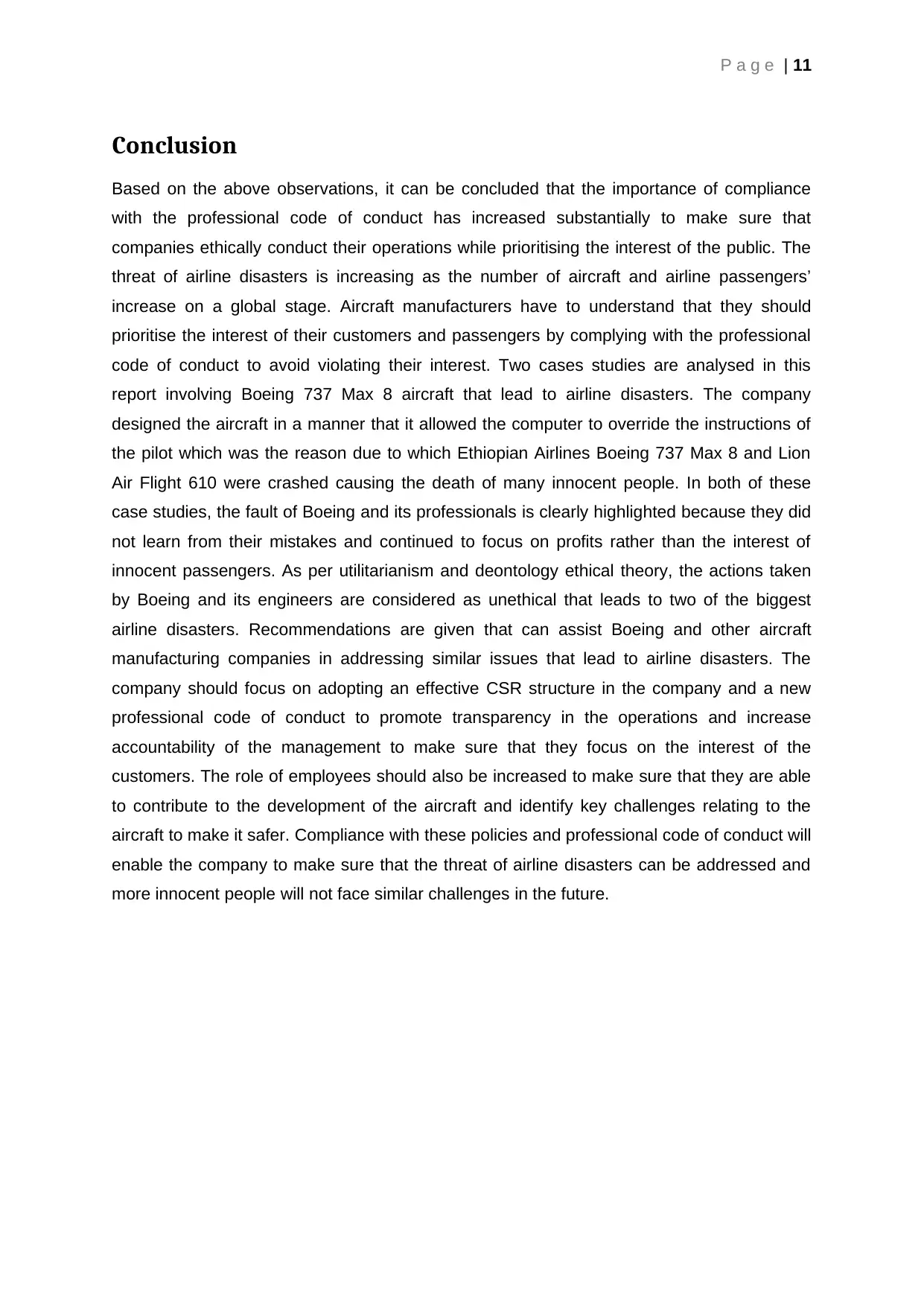
P a g e | 11
Conclusion
Based on the above observations, it can be concluded that the importance of compliance
with the professional code of conduct has increased substantially to make sure that
companies ethically conduct their operations while prioritising the interest of the public. The
threat of airline disasters is increasing as the number of aircraft and airline passengers’
increase on a global stage. Aircraft manufacturers have to understand that they should
prioritise the interest of their customers and passengers by complying with the professional
code of conduct to avoid violating their interest. Two cases studies are analysed in this
report involving Boeing 737 Max 8 aircraft that lead to airline disasters. The company
designed the aircraft in a manner that it allowed the computer to override the instructions of
the pilot which was the reason due to which Ethiopian Airlines Boeing 737 Max 8 and Lion
Air Flight 610 were crashed causing the death of many innocent people. In both of these
case studies, the fault of Boeing and its professionals is clearly highlighted because they did
not learn from their mistakes and continued to focus on profits rather than the interest of
innocent passengers. As per utilitarianism and deontology ethical theory, the actions taken
by Boeing and its engineers are considered as unethical that leads to two of the biggest
airline disasters. Recommendations are given that can assist Boeing and other aircraft
manufacturing companies in addressing similar issues that lead to airline disasters. The
company should focus on adopting an effective CSR structure in the company and a new
professional code of conduct to promote transparency in the operations and increase
accountability of the management to make sure that they focus on the interest of the
customers. The role of employees should also be increased to make sure that they are able
to contribute to the development of the aircraft and identify key challenges relating to the
aircraft to make it safer. Compliance with these policies and professional code of conduct will
enable the company to make sure that the threat of airline disasters can be addressed and
more innocent people will not face similar challenges in the future.
Conclusion
Based on the above observations, it can be concluded that the importance of compliance
with the professional code of conduct has increased substantially to make sure that
companies ethically conduct their operations while prioritising the interest of the public. The
threat of airline disasters is increasing as the number of aircraft and airline passengers’
increase on a global stage. Aircraft manufacturers have to understand that they should
prioritise the interest of their customers and passengers by complying with the professional
code of conduct to avoid violating their interest. Two cases studies are analysed in this
report involving Boeing 737 Max 8 aircraft that lead to airline disasters. The company
designed the aircraft in a manner that it allowed the computer to override the instructions of
the pilot which was the reason due to which Ethiopian Airlines Boeing 737 Max 8 and Lion
Air Flight 610 were crashed causing the death of many innocent people. In both of these
case studies, the fault of Boeing and its professionals is clearly highlighted because they did
not learn from their mistakes and continued to focus on profits rather than the interest of
innocent passengers. As per utilitarianism and deontology ethical theory, the actions taken
by Boeing and its engineers are considered as unethical that leads to two of the biggest
airline disasters. Recommendations are given that can assist Boeing and other aircraft
manufacturing companies in addressing similar issues that lead to airline disasters. The
company should focus on adopting an effective CSR structure in the company and a new
professional code of conduct to promote transparency in the operations and increase
accountability of the management to make sure that they focus on the interest of the
customers. The role of employees should also be increased to make sure that they are able
to contribute to the development of the aircraft and identify key challenges relating to the
aircraft to make it safer. Compliance with these policies and professional code of conduct will
enable the company to make sure that the threat of airline disasters can be addressed and
more innocent people will not face similar challenges in the future.
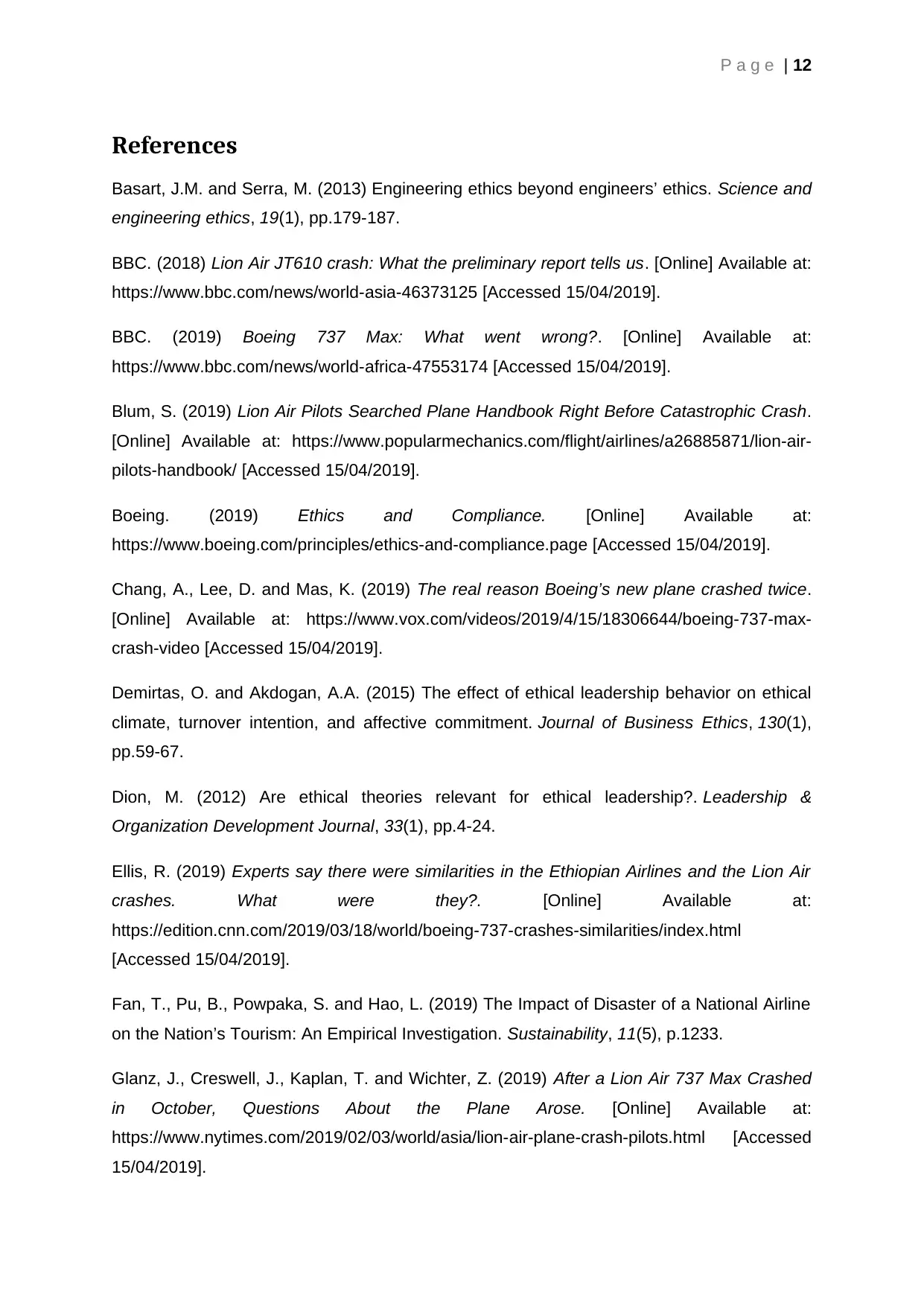
P a g e | 12
References
Basart, J.M. and Serra, M. (2013) Engineering ethics beyond engineers’ ethics. Science and
engineering ethics, 19(1), pp.179-187.
BBC. (2018) Lion Air JT610 crash: What the preliminary report tells us. [Online] Available at:
https://www.bbc.com/news/world-asia-46373125 [Accessed 15/04/2019].
BBC. (2019) Boeing 737 Max: What went wrong?. [Online] Available at:
https://www.bbc.com/news/world-africa-47553174 [Accessed 15/04/2019].
Blum, S. (2019) Lion Air Pilots Searched Plane Handbook Right Before Catastrophic Crash.
[Online] Available at: https://www.popularmechanics.com/flight/airlines/a26885871/lion-air-
pilots-handbook/ [Accessed 15/04/2019].
Boeing. (2019) Ethics and Compliance. [Online] Available at:
https://www.boeing.com/principles/ethics-and-compliance.page [Accessed 15/04/2019].
Chang, A., Lee, D. and Mas, K. (2019) The real reason Boeing’s new plane crashed twice.
[Online] Available at: https://www.vox.com/videos/2019/4/15/18306644/boeing-737-max-
crash-video [Accessed 15/04/2019].
Demirtas, O. and Akdogan, A.A. (2015) The effect of ethical leadership behavior on ethical
climate, turnover intention, and affective commitment. Journal of Business Ethics, 130(1),
pp.59-67.
Dion, M. (2012) Are ethical theories relevant for ethical leadership?. Leadership &
Organization Development Journal, 33(1), pp.4-24.
Ellis, R. (2019) Experts say there were similarities in the Ethiopian Airlines and the Lion Air
crashes. What were they?. [Online] Available at:
https://edition.cnn.com/2019/03/18/world/boeing-737-crashes-similarities/index.html
[Accessed 15/04/2019].
Fan, T., Pu, B., Powpaka, S. and Hao, L. (2019) The Impact of Disaster of a National Airline
on the Nation’s Tourism: An Empirical Investigation. Sustainability, 11(5), p.1233.
Glanz, J., Creswell, J., Kaplan, T. and Wichter, Z. (2019) After a Lion Air 737 Max Crashed
in October, Questions About the Plane Arose. [Online] Available at:
https://www.nytimes.com/2019/02/03/world/asia/lion-air-plane-crash-pilots.html [Accessed
15/04/2019].
References
Basart, J.M. and Serra, M. (2013) Engineering ethics beyond engineers’ ethics. Science and
engineering ethics, 19(1), pp.179-187.
BBC. (2018) Lion Air JT610 crash: What the preliminary report tells us. [Online] Available at:
https://www.bbc.com/news/world-asia-46373125 [Accessed 15/04/2019].
BBC. (2019) Boeing 737 Max: What went wrong?. [Online] Available at:
https://www.bbc.com/news/world-africa-47553174 [Accessed 15/04/2019].
Blum, S. (2019) Lion Air Pilots Searched Plane Handbook Right Before Catastrophic Crash.
[Online] Available at: https://www.popularmechanics.com/flight/airlines/a26885871/lion-air-
pilots-handbook/ [Accessed 15/04/2019].
Boeing. (2019) Ethics and Compliance. [Online] Available at:
https://www.boeing.com/principles/ethics-and-compliance.page [Accessed 15/04/2019].
Chang, A., Lee, D. and Mas, K. (2019) The real reason Boeing’s new plane crashed twice.
[Online] Available at: https://www.vox.com/videos/2019/4/15/18306644/boeing-737-max-
crash-video [Accessed 15/04/2019].
Demirtas, O. and Akdogan, A.A. (2015) The effect of ethical leadership behavior on ethical
climate, turnover intention, and affective commitment. Journal of Business Ethics, 130(1),
pp.59-67.
Dion, M. (2012) Are ethical theories relevant for ethical leadership?. Leadership &
Organization Development Journal, 33(1), pp.4-24.
Ellis, R. (2019) Experts say there were similarities in the Ethiopian Airlines and the Lion Air
crashes. What were they?. [Online] Available at:
https://edition.cnn.com/2019/03/18/world/boeing-737-crashes-similarities/index.html
[Accessed 15/04/2019].
Fan, T., Pu, B., Powpaka, S. and Hao, L. (2019) The Impact of Disaster of a National Airline
on the Nation’s Tourism: An Empirical Investigation. Sustainability, 11(5), p.1233.
Glanz, J., Creswell, J., Kaplan, T. and Wichter, Z. (2019) After a Lion Air 737 Max Crashed
in October, Questions About the Plane Arose. [Online] Available at:
https://www.nytimes.com/2019/02/03/world/asia/lion-air-plane-crash-pilots.html [Accessed
15/04/2019].
Paraphrase This Document
Need a fresh take? Get an instant paraphrase of this document with our AI Paraphraser
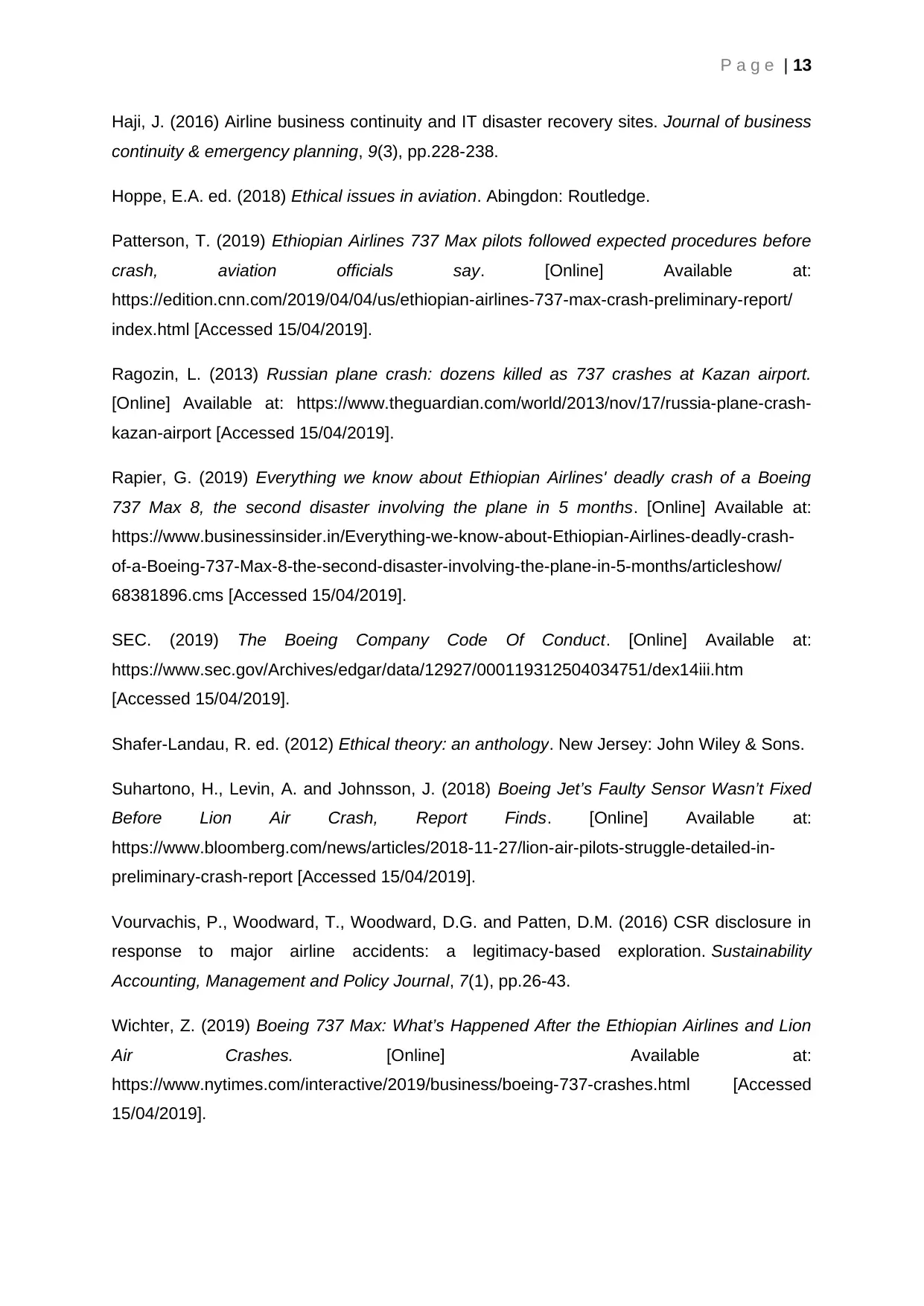
P a g e | 13
Haji, J. (2016) Airline business continuity and IT disaster recovery sites. Journal of business
continuity & emergency planning, 9(3), pp.228-238.
Hoppe, E.A. ed. (2018) Ethical issues in aviation. Abingdon: Routledge.
Patterson, T. (2019) Ethiopian Airlines 737 Max pilots followed expected procedures before
crash, aviation officials say. [Online] Available at:
https://edition.cnn.com/2019/04/04/us/ethiopian-airlines-737-max-crash-preliminary-report/
index.html [Accessed 15/04/2019].
Ragozin, L. (2013) Russian plane crash: dozens killed as 737 crashes at Kazan airport.
[Online] Available at: https://www.theguardian.com/world/2013/nov/17/russia-plane-crash-
kazan-airport [Accessed 15/04/2019].
Rapier, G. (2019) Everything we know about Ethiopian Airlines' deadly crash of a Boeing
737 Max 8, the second disaster involving the plane in 5 months. [Online] Available at:
https://www.businessinsider.in/Everything-we-know-about-Ethiopian-Airlines-deadly-crash-
of-a-Boeing-737-Max-8-the-second-disaster-involving-the-plane-in-5-months/articleshow/
68381896.cms [Accessed 15/04/2019].
SEC. (2019) The Boeing Company Code Of Conduct. [Online] Available at:
https://www.sec.gov/Archives/edgar/data/12927/000119312504034751/dex14iii.htm
[Accessed 15/04/2019].
Shafer-Landau, R. ed. (2012) Ethical theory: an anthology. New Jersey: John Wiley & Sons.
Suhartono, H., Levin, A. and Johnsson, J. (2018) Boeing Jet’s Faulty Sensor Wasn’t Fixed
Before Lion Air Crash, Report Finds. [Online] Available at:
https://www.bloomberg.com/news/articles/2018-11-27/lion-air-pilots-struggle-detailed-in-
preliminary-crash-report [Accessed 15/04/2019].
Vourvachis, P., Woodward, T., Woodward, D.G. and Patten, D.M. (2016) CSR disclosure in
response to major airline accidents: a legitimacy-based exploration. Sustainability
Accounting, Management and Policy Journal, 7(1), pp.26-43.
Wichter, Z. (2019) Boeing 737 Max: What’s Happened After the Ethiopian Airlines and Lion
Air Crashes. [Online] Available at:
https://www.nytimes.com/interactive/2019/business/boeing-737-crashes.html [Accessed
15/04/2019].
Haji, J. (2016) Airline business continuity and IT disaster recovery sites. Journal of business
continuity & emergency planning, 9(3), pp.228-238.
Hoppe, E.A. ed. (2018) Ethical issues in aviation. Abingdon: Routledge.
Patterson, T. (2019) Ethiopian Airlines 737 Max pilots followed expected procedures before
crash, aviation officials say. [Online] Available at:
https://edition.cnn.com/2019/04/04/us/ethiopian-airlines-737-max-crash-preliminary-report/
index.html [Accessed 15/04/2019].
Ragozin, L. (2013) Russian plane crash: dozens killed as 737 crashes at Kazan airport.
[Online] Available at: https://www.theguardian.com/world/2013/nov/17/russia-plane-crash-
kazan-airport [Accessed 15/04/2019].
Rapier, G. (2019) Everything we know about Ethiopian Airlines' deadly crash of a Boeing
737 Max 8, the second disaster involving the plane in 5 months. [Online] Available at:
https://www.businessinsider.in/Everything-we-know-about-Ethiopian-Airlines-deadly-crash-
of-a-Boeing-737-Max-8-the-second-disaster-involving-the-plane-in-5-months/articleshow/
68381896.cms [Accessed 15/04/2019].
SEC. (2019) The Boeing Company Code Of Conduct. [Online] Available at:
https://www.sec.gov/Archives/edgar/data/12927/000119312504034751/dex14iii.htm
[Accessed 15/04/2019].
Shafer-Landau, R. ed. (2012) Ethical theory: an anthology. New Jersey: John Wiley & Sons.
Suhartono, H., Levin, A. and Johnsson, J. (2018) Boeing Jet’s Faulty Sensor Wasn’t Fixed
Before Lion Air Crash, Report Finds. [Online] Available at:
https://www.bloomberg.com/news/articles/2018-11-27/lion-air-pilots-struggle-detailed-in-
preliminary-crash-report [Accessed 15/04/2019].
Vourvachis, P., Woodward, T., Woodward, D.G. and Patten, D.M. (2016) CSR disclosure in
response to major airline accidents: a legitimacy-based exploration. Sustainability
Accounting, Management and Policy Journal, 7(1), pp.26-43.
Wichter, Z. (2019) Boeing 737 Max: What’s Happened After the Ethiopian Airlines and Lion
Air Crashes. [Online] Available at:
https://www.nytimes.com/interactive/2019/business/boeing-737-crashes.html [Accessed
15/04/2019].
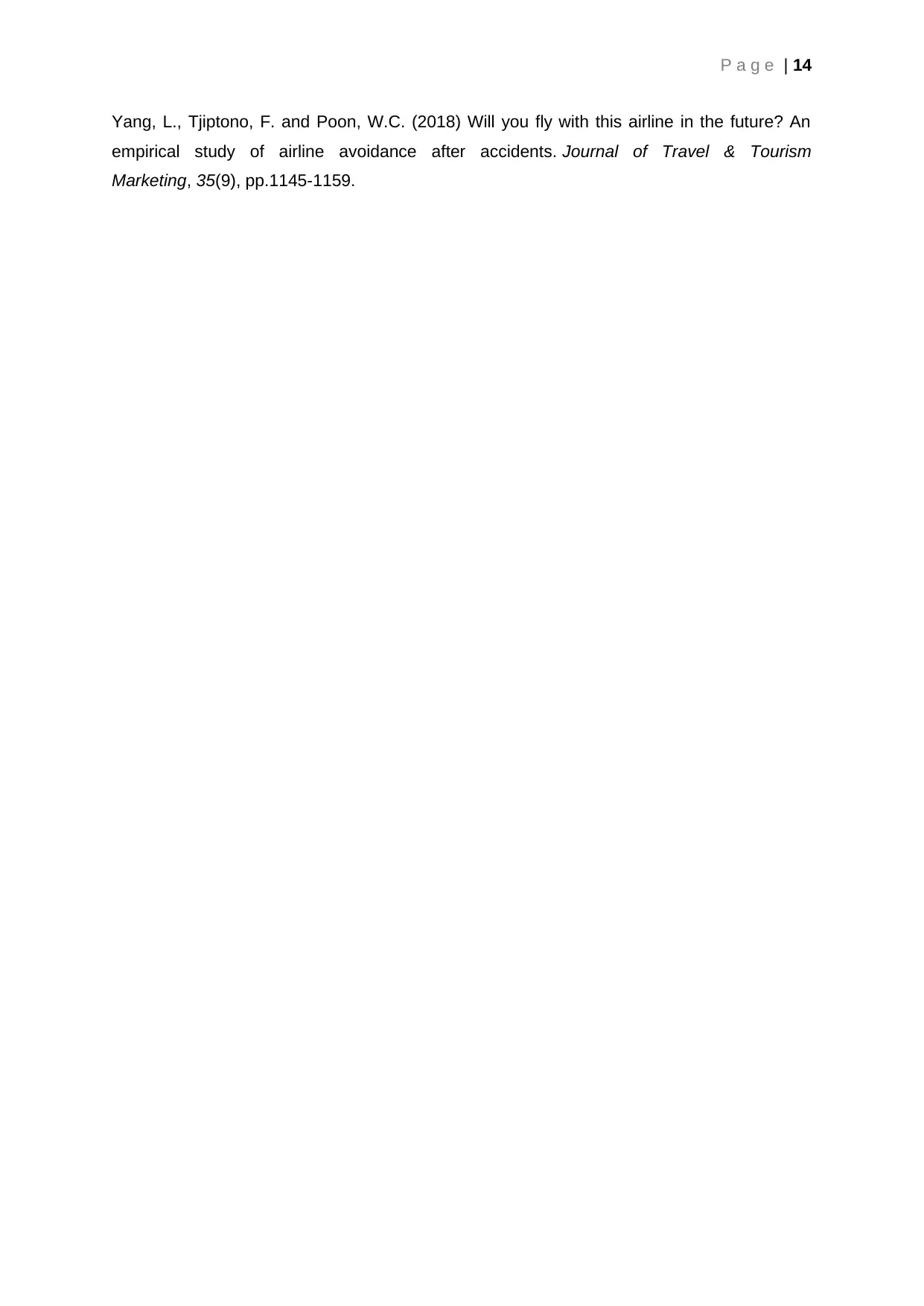
P a g e | 14
Yang, L., Tjiptono, F. and Poon, W.C. (2018) Will you fly with this airline in the future? An
empirical study of airline avoidance after accidents. Journal of Travel & Tourism
Marketing, 35(9), pp.1145-1159.
Yang, L., Tjiptono, F. and Poon, W.C. (2018) Will you fly with this airline in the future? An
empirical study of airline avoidance after accidents. Journal of Travel & Tourism
Marketing, 35(9), pp.1145-1159.
1 out of 15
Related Documents
Your All-in-One AI-Powered Toolkit for Academic Success.
+13062052269
info@desklib.com
Available 24*7 on WhatsApp / Email
![[object Object]](/_next/static/media/star-bottom.7253800d.svg)
Unlock your academic potential
© 2024 | Zucol Services PVT LTD | All rights reserved.





